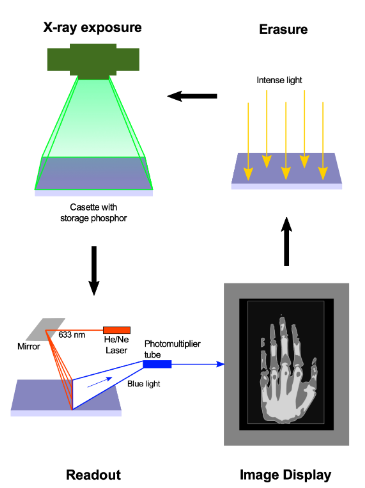Computed Radiography (CR) and Digital Radiography (DR)
Although film radiography is still popularly used in many NDT applications, Computed Radiography (CR) and Digital Radiography (DR) have replaced film in many areas. Film radiography has been discussed in previous sections. This section briefly compares CR and DR. Comparing to film radiography, both of them provide digital X-ray images.
CR generates digital images indirectly. It uses an Imaging Plate (IP), which can be considered as reusable films contain photostimulable phosphor, to detect the X-ray radiation. After exposure to X-ray, the IP is then read by the CR scanner to convert the captured information into a digital image. After the IP is read, exposing the IP to room-intensity white light will erase the left information and get the IP ready for X-ray exposure again. Below figure shows the process for CR.

The process of computed radiography by Beevil from
https://commons.wikimedia.org/wiki/File:Computed_Radiography_Process.svg
DR generates digital images directly like a digital camera. It uses a radiation-sensitive flat panel (Digital Detector Array or DDA, 2D imager), or uses a Linear Diode Array (LDA, 1D imager) to scan, to capture radiation signals into a 2D pixel matrix and generates digital images. There are two types of conversion process from X-ray radiation to digital image. Indirect conversion uses scintillator to convert X-ray photons to visible light photons, then captured by CCD, CMOS or other electronics array to create a digital image. Direct conversion use semiconductor layer to directly convert X-ray photon signal to electronics signals. As illustrating in the figure below, Direct conversion detector typically provides better spatial resolution by eliminating the optical conversion step and spreading of photons in scintillator.

Direct and indirect flat panel detectors by Beevil from
https://commons.wikimedia.org/wiki/File:Resolution_in_direct_and_indirect_x-ray_detectors.svg
Comparing to film radiography, CR eliminates the need of chemical development process and dark room, generates digital images instead of film images, and still keeps the flexibility to bend around the object. However, CR still relies on a scanner for readout. DR offers instantaneous X-ray digital images with high signal to noise ratio, but its field applications may be limited in some scenarios, since the detectors are rigid, fragile and expensive electronics.